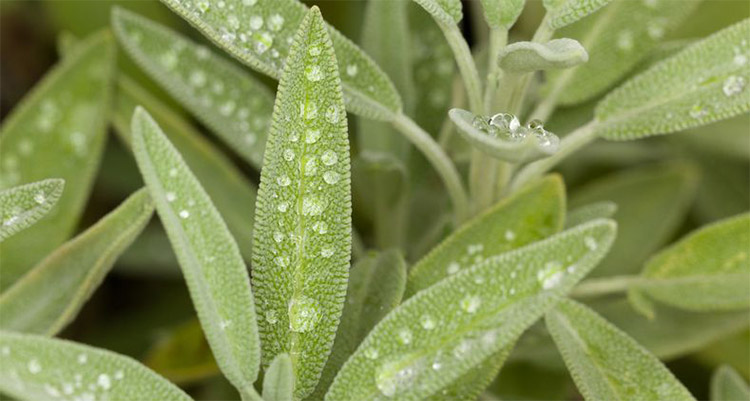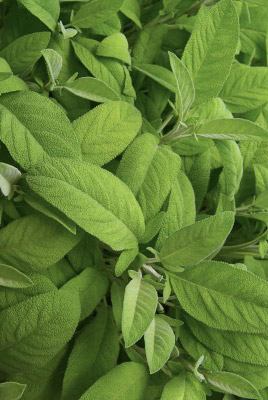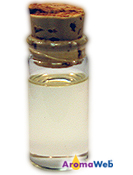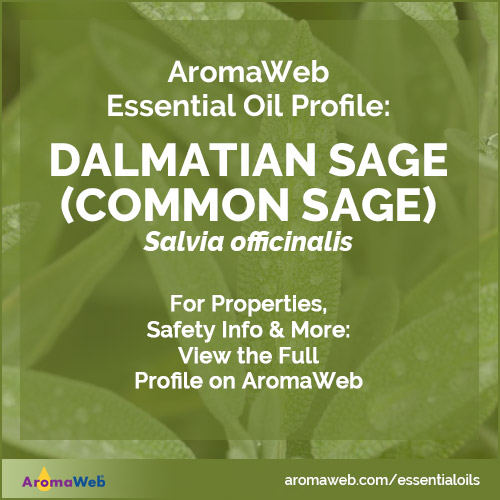Dalmatian Sage Essential Oil
Salvia officinalis

Description
Dalmatian Sage Essential Oil is also known as Common Sage Essential Oil.
Essential oil that is steam distilled specifically from the plant Salvia officinalis is referred to by several common names including Common Sage, and Dalmatian Sage. Typically, when someone simply refers to Sage Essential Oil (as I will continue to do so within this profile), he/she generally is referring to the oil of Salvia officinalis, the oil that is profiled here. However, it's always best to verify by confirming the botanical name of the specific "sage" essential oil that you are working with or considering for purchase. Greek Sage Essential Oil, Spanish Sage Essential Oil and Clary Sage Essential Oil are also available, and the composition and safety guidelines for each varies.

Aromatically, Dalmatian Sage Essential Oil possesses an herbaceous, fruity, fresh, camphorous aroma that blends well with essential oils in the citrus, spice, mint, wood and herbaceous families.
Dalmatian Sage Essential Oil contains approximately 25-50% thujone, a ketone that requires greater care and more limited use. Refer to the Safety Information section below for more information.

Sage Essential Oil Benefits and Uses
- Muscular Aches
- Joints
- Headaches
- Digestive Upsets
- Sore Throat
- Menstrual Cramping
- Nervousness
- Mental Fatigue
- Emotional Exhaustion
- Memory Loss
- Acne
Source: Valerie Ann Worwood, The Complete Book of Essential Oils and Aromatherapy, 25th Anniversary Edition (Novato, CA: New World Library, 2016, 619.
Fragrancing in very low dilutions. Source: Julia Lawless, The Encyclopedia of Essential Oils (Updated Edition) (London: Harper Thorsons, 2014), 177-178.
Botanical Name
Plant Family
Common Method of Extraction
Steam Distilled
Plant Part Typically Used
Color
Clear
Consistency
Medium
Perfumery Note
Top
Strength of Initial Aroma
Strong
Aromatic Description
Dalmatian Sage Essential Oil smells herbaceous, fruity, fresh and camphorous.
Sustainability and Conservation Status
Least Concern
Source: https://www.iucnredlist.org/species/203260/2762648
To learn more about the conservation status of essential oil bearing plants and how to use the IUCN Red List of Threatened Species, please refer to AromaWeb's Guide to Essential Oils and Sustainability.
Major Constituents
- Camphor
- a-Thujone
- Borneol
- 1,8-Cineole
- B-Thujone
- B-Caryophyllene
See Essential Oil Safety for a more complete list of typical constituents.
Source: B.M. Lawrence, Progress in Essential Oils. (Perfumer & Flavorist 23 no. 2, 1998), 50. Source cited in Robert Tisserand and Rodney Young, Essential Oil Safety (Second Edition. United Kingdom: Churchill Livingstone Elsevier, 2014), 414.
Dalmatian Sage Essential Oil Safety Information
High thujone content. Use sparingly and with extreme caution. Spanish Sage Essential Oil is somewhat safer to work with. Tisserand and Young warn of the possibility of neurotoxicity. Avoid Sage Oil in pregnancy and breastfeeding. They recommend a dermal maximum of 0.4%. Reading Tisserand and Young's full profile is recommended. [Robert Tisserand and Rodney Young, Essential Oil Safety (Second Edition. United Kingdom: Churchill Livingstone Elsevier, 2014), 414.]
This essential oil poses a higher risk of causing irritation and sensitization when used in the bath. Avoid using it in the bath, even if it is solubilized/diluted.
General Safety Information
Do not take any oils internally and do not apply undiluted essential oils, absolutes, CO2s or other concentrated essences onto the skin without advanced essential oil knowledge or consultation from a qualified aromatherapy practitioner. For general dilution information, read AromaWeb's Guide to Diluting Essential Oils. If you are pregnant, epileptic, have liver damage, have cancer, or have any other medical problem, use oils only under the proper guidance of a qualified aromatherapy practitioner. Use extreme caution when using oils with children and be sure to first read the recommended dilution ratios for children. Consult a qualified aromatherapy practitioner before using oils with children, the elderly, if you have medical issues or are taking medications. Before using this or any essential oil, carefully read AromaWeb's Essential Oil Safety Information page. For in-depth information on oil safety issues, read Essential Oil Safety by Robert Tisserand and Rodney Young.
Shelf Life
Important Information About the Profiles
The essential oil information provided on AromaWeb is intended for basic educational purposes only. The references to safety information, test results, constituents and percentages is generalized information. Essential oils can vary greatly in composition. The data is not necessary complete and is not guaranteed to be accurate. The essential oil photos are intended to represent the typical and approximate color of each essential oil. However, essential oil composition and color can vary based on harvesting, distillation, age of the essential oil and other factors. Profiles for several CO2 Extracts and absolutes are included within the directory, and are denoted as such.
